Synchronous EUS-guided choledochoduodenostomy with metallic biliary and duodenal stents placement in a patient with malignant papillary tumor
- PMID: 23687594
- PMCID: PMC3655349
- DOI: 10.4161/jig.22206
Synchronous EUS-guided choledochoduodenostomy with metallic biliary and duodenal stents placement in a patient with malignant papillary tumor
Keywords: EUS-Guided Choledochoduodenostomy (EUS-CDS); ampullary cancer; biliary obstruction; duodenal obstruction; failed ERCP; metallic stents.
Figures


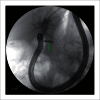
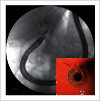
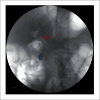
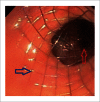
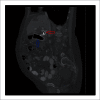
Similar articles
-
Multicenter comparative evaluation of endoscopic placement of expandable metal stents for malignant distal common bile duct obstruction by ERCP or EUS-guided approach.Gastrointest Endosc. 2015 Apr;81(4):913-23. doi: 10.1016/j.gie.2014.09.054. Epub 2014 Dec 5. Gastrointest Endosc. 2015. PMID: 25484326
-
Simultaneous Duodenal Metal Stent Placement and EUS-Guided Choledochoduodenostomy for Unresectable Pancreatic Cancer.Gut Liver. 2012 Jul;6(3):399-402. doi: 10.5009/gnl.2012.6.3.399. Epub 2012 Jul 12. Gut Liver. 2012. PMID: 22844572 Free PMC article.
-
Comparison of the clinical impact of endoscopic ultrasound-guided choledochoduodenostomy and hepaticogastrostomy for bile duct obstruction with duodenal obstruction.Endoscopy. 2016 Feb;48(2):156-63. doi: 10.1055/s-0034-1392859. Epub 2015 Sep 18. Endoscopy. 2016. PMID: 26382307
-
EUS-guided biliary drainage for malignant hilar biliary obstruction: A concise review.Endosc Ultrasound. 2021 May-Jun;10(3):154-160. doi: 10.4103/EUS-D-21-00004. Endosc Ultrasound. 2021. PMID: 34137381 Free PMC article. Review.
-
EUS-guided Choledochoduodenostomy Versus Hepaticogastrostomy: A Systematic Review and Meta-analysis.J Clin Gastroenterol. 2018 Feb;52(2):123-130. doi: 10.1097/MCG.0000000000000948. J Clin Gastroenterol. 2018. PMID: 29095426
Cited by
-
Application of chemokine receptor antagonist with stents reduces local inflammation and suppresses cancer growth.Tumour Biol. 2015 Nov;36(11):8637-43. doi: 10.1007/s13277-015-3557-1. Epub 2015 Jun 5. Tumour Biol. 2015. PMID: 26044561
References
-
- Ferrucci J, Jr, Mueller PR, Harbin WP. Percutaneous transhepatic biliary drainage: technique, results, and applications. Radiology. 1980;135:1–1. - PubMed
-
- Smith AC, Dowsett JF, Russell RC, Hatfield AR, Cotton PB. Randomized trial of endoscopic stenting versus surgical bypass in malignant low bile duct obstruction. Lancet. 1994;344:1655–1660. - PubMed
-
- Kama NA, Coskun T, Yuksek YN, Yazgan A. Factors affecting post-operative mortality in malignant biliary tract obstruction. Hepatogastroenterology. 1999;46:103–107. - PubMed
-
- Kenji Y, Akira S, Kuniyuki T, Hiroshi I, Reiko A, Nobumasa M. EUS-guided choledochoduodenostomy for palliative biliary drainage in case of papillary obstruction: report of 2 cases. Gastrointestinal Endoscopy. 2006;64:663–667. - PubMed
-
- Shigetaka Y, Kenji Y, Vikram V, Nobumasa M, Akira S, Masahiro T, et al. Endoscopic ultrasound-guided choledochoduodenostomy for treatment of ampullary cancer. Clin J Gastroenterol. 2008;2:55–58. - PubMed
LinkOut - more resources
Full Text Sources
